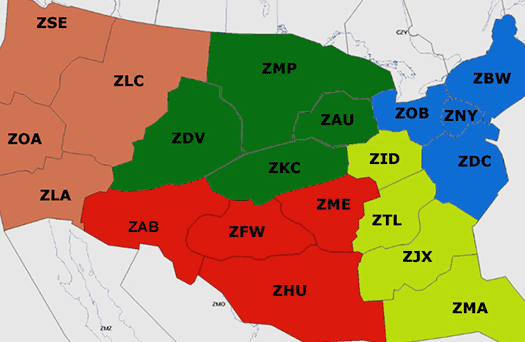
A central element of FileSmart is seeing the “big picture” and understanding how the National Airspace System (NAS) is managed. Management of the NAS is accomplished through the use of traffic flow management (TFM), which is defined as managing the flow of traffic based on capacity and demand at airports and in the airspace.
The Structure of the NAS
The NAS encompasses all airspace over the contiguous United States, Alaska, Hawaii and certain U.S. territories.
The NAS is comprised of 20 En Route Centers, each controlling section of airspace over the continental U.S. Each center oversees any TRACON and tower-controlled airspace within its boundaries.
The entire NAS is overseen and coordinated by the FAA’s Air Traffic Control System Command Center (ATCSCC), located in Warrenton, VA. The Command Center is the final authority in making decisions about how to handle constraints in the NAS.
What is Traffic Flow Management?
While many operators only think of air traffic control (ATC) as a control tower or an En Route Center, the reality is that there is much more going on behind the scenes to manage the thousands of aircraft in the NAS at any given time. TFM exists to manage that “big picture.”
Traffic flow management can be defined as the “managing of the flow of air traffic in the National Airspace System (NAS) based on capacity and demand.” TFM is a part of ATC, but its focus is different. Where much of ATC is centered around controlling and separating specific flights, the role of TFM is to manage the overall flow – taking a “system-wide approach” to ensure that there is a plan as to where and when aircraft fly within the NAS.
A big part of making TFM work is the emphasis on collaboration and consensus. Before a decision is made on a course of action, traffic managers will collaborate with other ATC facilities, with the industry (airlines, business/general aviation), the military and others. This process is known as collaborative decision making (CDM).
Why Does Traffic Flow Management Exist?
Traffic flow management exists to:
- Maximize efficiency
- Minimize delays
- Ensure equity in the NAS
Delays can be caused by constraints in the NAS, such as weather, special events, temporary flight restrictions (TFRs) and excessive or unanticipated traffic.
TFM considers who or what may be affected by a constraint and focuses on a coordinated effort to ensure equitable handling of that constraint and to minimize the associated delays.
While many operators tend to focus on a specific delay they might have been issued, that delay be the result of a TFM initiative intended to benefit the whole of the NAS.
What Does Traffic Flow Management Do?
The goal of TFM is to balance capacity with demand in both the terminal (airport-specific) and en route portions of the NAS. In other words, it exists to make sure that there are not too many aircraft heading to or from an airport, or flying through a specific area of airspace, at one time.
When conditions are not favorable, either at an airport, or in a section of airspace, air traffic managers must find ways to slow down, and reduce the volume of, the traffic in these areas. This is done through the use of traffic management initiatives (TMIs).
If this is done successfully, overall delays in the NAS will be reduced.
